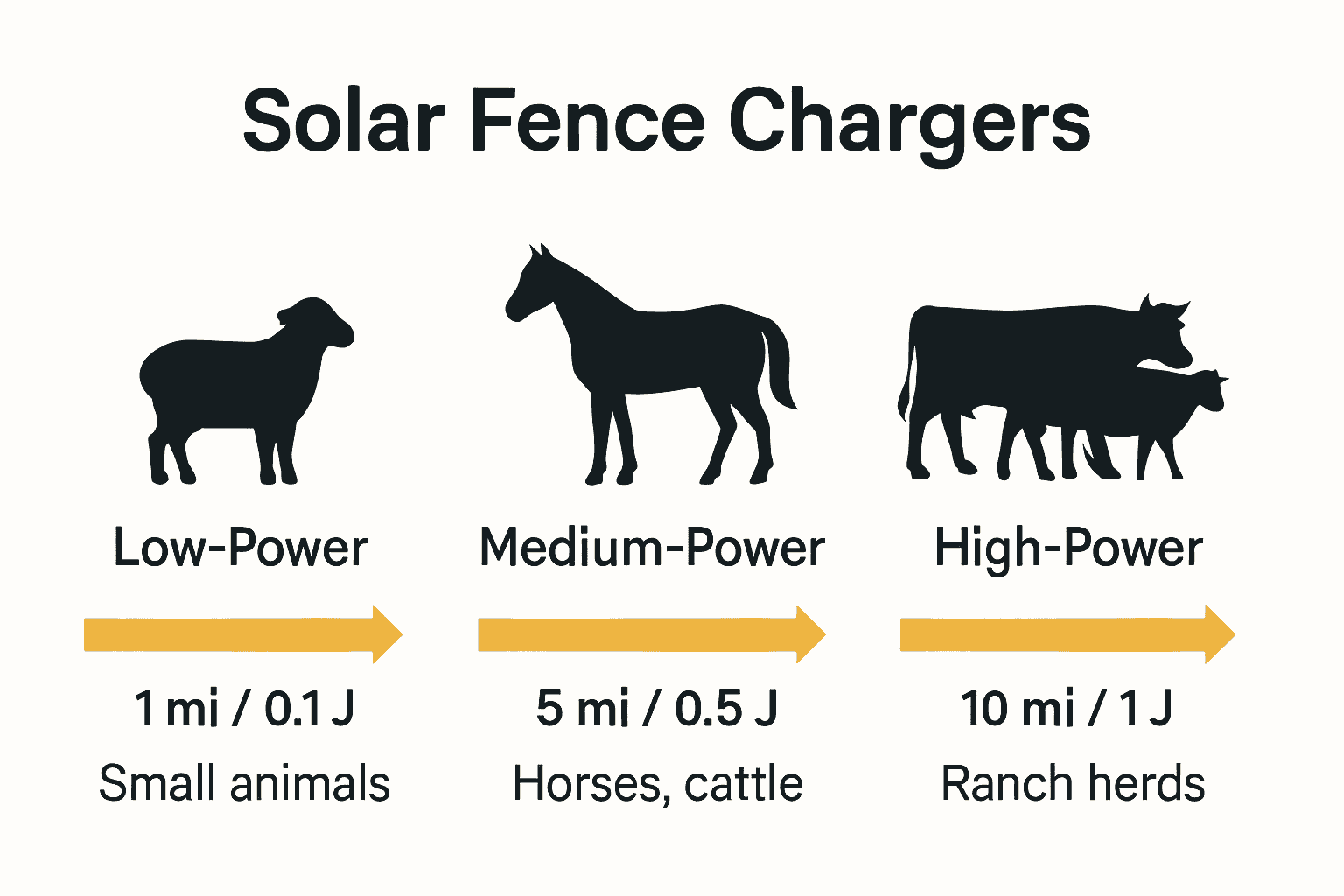Protecting livestock and crops in remote locations can be tough when there is no easy access to electricity. Over 40 percent of rural agricultural fences now rely on solar-powered solutions, thanks to their ability to deliver steady power without external wiring. Understanding solar fence chargers is crucial for anyone looking for efficient, affordable, and eco-friendly ways to secure their property. This guide breaks down how these innovative devices work, what options exist, and what you need to know to choose the right system.
Table of Contents
- Defining Solar Fence Chargers And Core Functions
- Different Types Of Solar Fence Chargers Explained
- How Solar Fence Chargers Operate Effectively
- Installation, Maintenance, And Best Practices
- Comparing Costs, Benefits, And Common Pitfalls
Key Takeaways
| Point | Details |
|---|---|
| Solar Fence Charger Definition | A solar fence charger powers electric fencing using solar energy, ideal for remote areas without electricity. |
| Types of Chargers | They are categorized into low, medium, and high-power types, addressing varying fencing needs for different livestock and property sizes. |
| Operational Mechanism | They convert sunlight to electrical energy stored in batteries, supplying consistent power to fences regardless of sunlight availability. |
| Installation Best Practices | Proper location, grounding, and solar panel orientation are crucial to maximize performance and lifespan of solar fence chargers. |
Defining Solar Fence Chargers and Core Functions
A solar fence charger is an innovative power solution designed to electrify agricultural and rural perimeter fencing using renewable solar energy. According to Virginia Tech Publications, these portable devices utilize a battery recharged by a solar panel to supply power to electric fences, making them ideal for areas without traditional electrical service.
The core function of solar fence chargers revolves around converting sunlight into electrical energy through integrated photovoltaic panels. These panels capture solar radiation and transform it into electrical current, which is stored in a rechargeable battery. As University of Missouri Extension explains, this mechanism provides an effective solution for electrifying fences in remote locations without direct access to main power infrastructure.
Key components of a solar fence charger typically include:
- Photovoltaic solar panel
- Rechargeable battery storage unit
- Electrical energizer/controller
- Grounding system
- Weatherproof housing
The primary advantages of solar fence chargers extend beyond mere power generation. They offer agricultural and rural property owners a sustainable, flexible, and maintenance-friendly solution for securing livestock boundaries, protecting crops, and managing property perimeters. Learn more about portable solar electric fence solutions to understand how these innovative systems can transform your property management approach.
Different Types of Solar Fence Chargers Explained
Solar fence chargers are not a one-size-fits-all solution, but rather a diverse category of equipment designed to meet varying agricultural and rural property needs. According to Virginia Tech Publications, these solar energizers differ significantly in output, with most providing less than 1 joule, while larger models can reach up to 2 joules, accommodating different fencing requirements.
These solar fence chargers can be broadly categorized into three primary types:
- Low-Power Solar Chargers (0.1 - 0.5 joules)
- Ideal for small pastures
- Suitable for lightweight livestock like sheep or goats
- Minimal power consumption
- Compact and portable design
- Medium-Power Solar Chargers (0.5 - 1.5 joules)
- Perfect for medium-sized livestock operations
- Effective for cattle and horse enclosures
- Moderate solar panel capacity
- Balanced performance and energy efficiency
- High-Power Solar Chargers (1.5 - 2.5 joules)
- Designed for extensive fencing systems
- Recommended for large ranches and farms
- Robust solar panel configurations
- Maximum coverage and voltage output
As University of Missouri Extension explains, solar-powered chargers vary in sizes and capacities, with larger units capable of delivering higher voltage and intensity. When selecting a solar fence charger, consider factors like pasture size, livestock type, and geographic location.
 Check out our comprehensive guide to the best solar electric fence chargers to make an informed decision tailored to your specific agricultural needs.
Check out our comprehensive guide to the best solar electric fence chargers to make an informed decision tailored to your specific agricultural needs.
How Solar Fence Chargers Operate Effectively
Solar fence chargers transform sunlight into a powerful electrical barrier for livestock and property protection through a sophisticated yet straightforward energy conversion process. According to Virginia Tech Publications, these solar energizers operate by converting sunlight into electrical energy stored in a battery, with proper matching of components ensuring low maintenance and effective operation.
The operational mechanism of solar fence chargers involves several critical stages:
- Solar Energy Capture
- Photovoltaic panels absorb direct sunlight
- Semiconductor materials convert light into electrical current
- Energy collected throughout daylight hours
- Battery Storage
- Electrical current stored in rechargeable batteries
- Continuous energy preservation for nighttime and low-light conditions
- Ensures consistent fence power supply
- Power Distribution
- Stored energy transformed into controlled electrical pulses
- Distributed through fence wire at regular intervals
- Creates deterrent shock for animal containment
As University of Missouri Extension explains, effective operation depends critically on adequate sunlight exposure and proper installation to ensure the battery remains consistently charged. When positioning your solar fence charger, prioritize locations with maximum sun exposure and minimal shade interference. Learn how to install and maintain a solar fence energizer system with our comprehensive guide to maximize your system’s performance and reliability.
Installation, Maintenance, and Best Practices
Solar fence chargers require strategic planning and careful implementation to ensure optimal performance and longevity. According to Virginia Tech Publications, proper installation is critical and includes using insulated lead-out cables and ensuring tight connections to prevent potential voltage leaks and maintain system integrity.
Key Installation Steps
- Location Selection
- Choose elevated, dry areas
- Ensure direct sunlight exposure
- Protect from direct moisture and extreme weather
- Mount at least 3-4 feet above ground level
- Grounding System Setup
- Install multiple ground rods (typically 3-6 feet long)
- Space ground rods 10 feet apart
- Use copper or galvanized steel rods
- Ensure consistent soil contact
- Solar Panel Positioning
- Face panels toward true south
- Optimize 30-45 degree mounting angle
- Clear surrounding vegetation
- Minimize shade interference
As University of Missouri Extension recommends, best practices involve placing the charger in a dry, accessible location with appropriate grounding and solar panel orientation to maximize sunlight reception. Regular maintenance is crucial for long-term performance.
IMAGE:descriptive_key_1] [Explore our comprehensive guide to installing a solar fence energizer system for detailed insights into creating a robust, reliable electric fencing solution.
Comparing Costs, Benefits, and Common Pitfalls
Solar fence chargers represent a nuanced investment for agricultural and rural property owners, balancing upfront expenses with long-term operational advantages. According to Virginia Tech Publications, while these solar energizers may have higher initial costs, they offer low maintenance and are ideal for remote areas without electrical service, effectively offsetting the need for frequent battery replacements.
Cost Breakdown
Initial Investment
- Solar panel unit: $150 - $500
- Installation materials: $50 - $150
- Professional setup (optional): $100 - $300
- Total estimated cost: $300 - $950
Long-Term Savings
- Zero electrical connection costs
- Minimal battery replacement expenses
- Reduced maintenance requirements
- Environmentally sustainable solution
Common Pitfalls to Avoid
- Inadequate Sunlight Exposure
- Insufficient panel positioning
- Excessive shade interference
- Reduced charging efficiency
- Poor Grounding
- Ineffective electrical circuit
- Reduced fence performance
- Potential safety risks
As University of Missouri Extension explains, solar-powered chargers eliminate battery replacement costs and associated inconveniences, but require proper installation and consistent sunlight exposure to function effectively. Explore our comprehensive guide to solar electric fence chargers to make an informed decision that balances your agricultural needs and budget constraints.
Discover Reliable Solar Fence Charger Solutions for Your Farm
Managing livestock boundaries with solar fence chargers means facing challenges like ensuring consistent sunlight exposure, proper grounding, and selecting the right power output for your operation. These concerns can feel overwhelming when you need a dependable, low-maintenance electric fencing system to protect your animals and crops.
At FenceFast.ca, we understand how crucial a well-designed fencing setup is to your peace of mind and daily farm work. We offer a broad range of electric fencing components and solar power supplies tailored for Canadian farmers and ranchers. Whether you need compact low-power chargers for sheep or heavy-duty options for large ranches, our products and expert advice will help you build a system that works flawlessly in any remote location.

Explore our complete selection of electric fencing systems and components at FenceFast.ca to find the perfect solar fence charger and accessories. Take control of your fencing project today by visiting FenceFast.ca and start securing your livestock with confidence and efficiency.
Frequently Asked Questions
What is a solar fence charger?
A solar fence charger is a device that electrifies agricultural and rural fencing using solar energy. It converts sunlight into electrical power and stores it in a rechargeable battery, making it ideal for remote areas without access to conventional electrical services.
How do solar fence chargers operate?
Solar fence chargers capture sunlight through photovoltaic panels, converting it into electrical energy that is stored in a battery. This stored energy is then transformed into controlled electrical pulses that flow through the fence wire to deter animals and protect property.
What are the different types of solar fence chargers?
Solar fence chargers are categorized into three types based on their power output: low-power (0.1 - 0.5 joules) for small pastures, medium-power (0.5 - 1.5 joules) for medium-sized livestock, and high-power (1.5 - 2.5 joules) for extensive fencing systems in large farms and ranches.
What factors should I consider when installing a solar fence charger?
When installing a solar fence charger, consider the location for maximum sunlight exposure, effective grounding using multiple ground rods, and the proper positioning of the solar panel to reduce shade interference. Proper installation significantly enhances performance and reliability.
